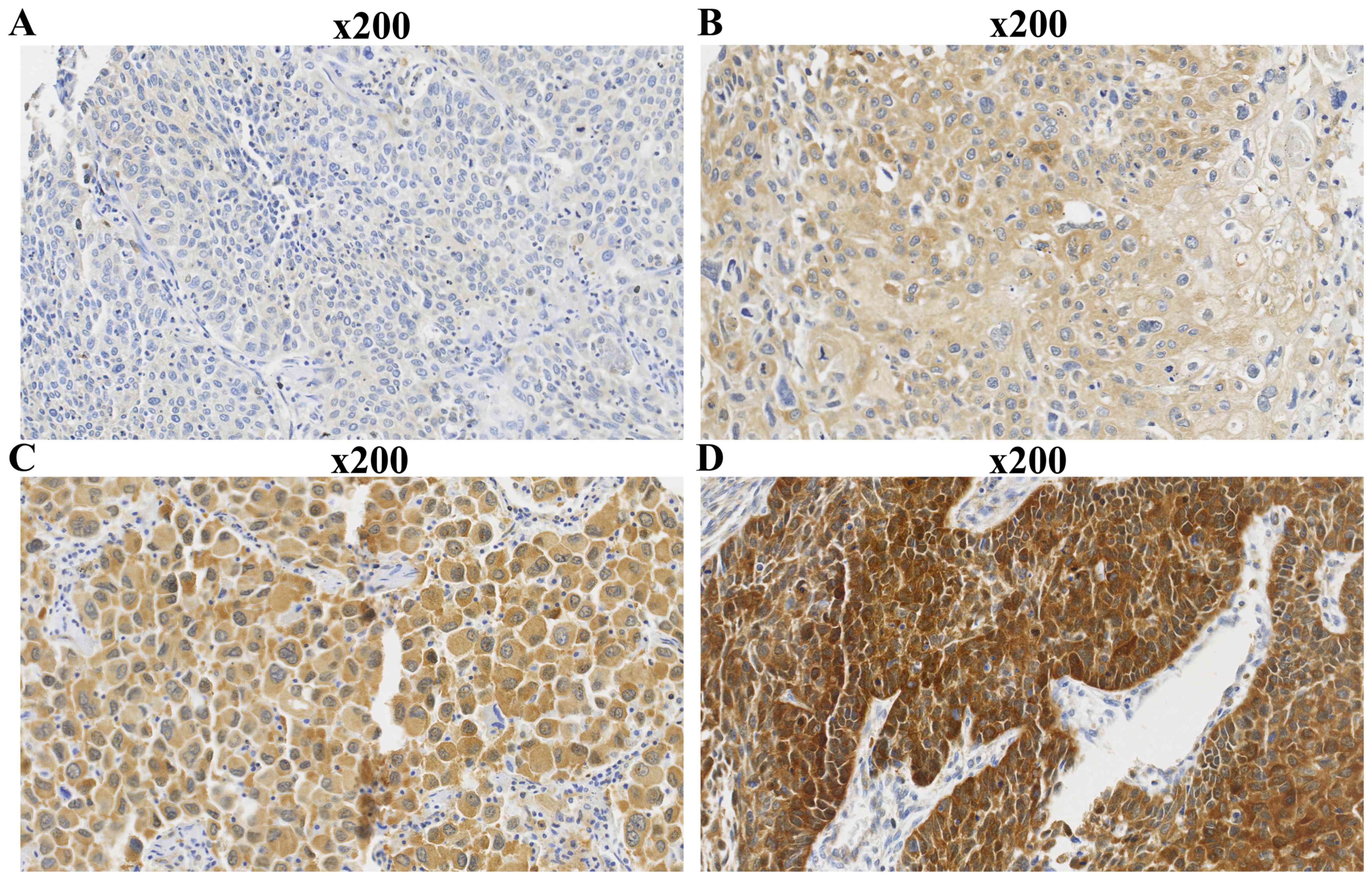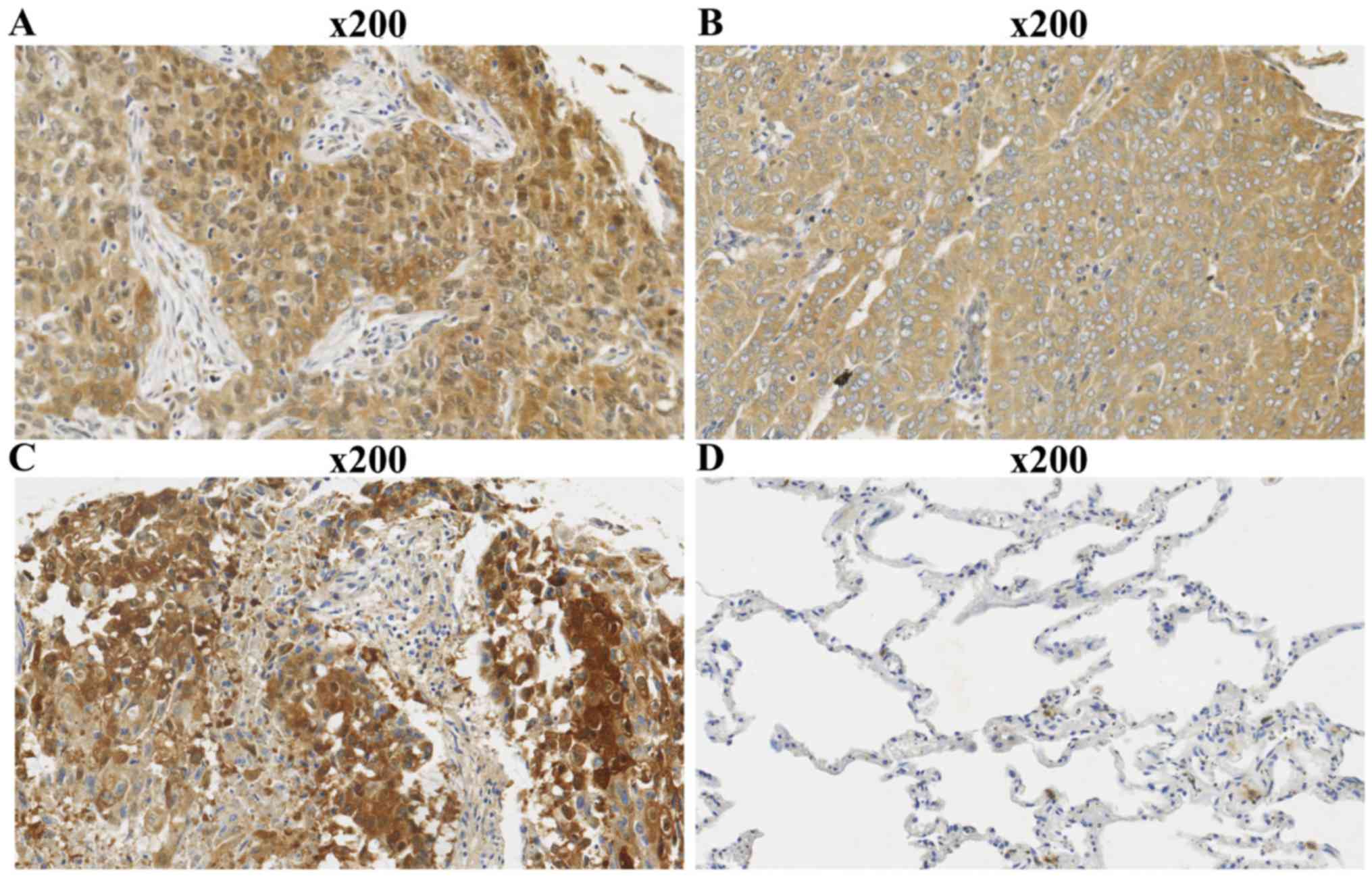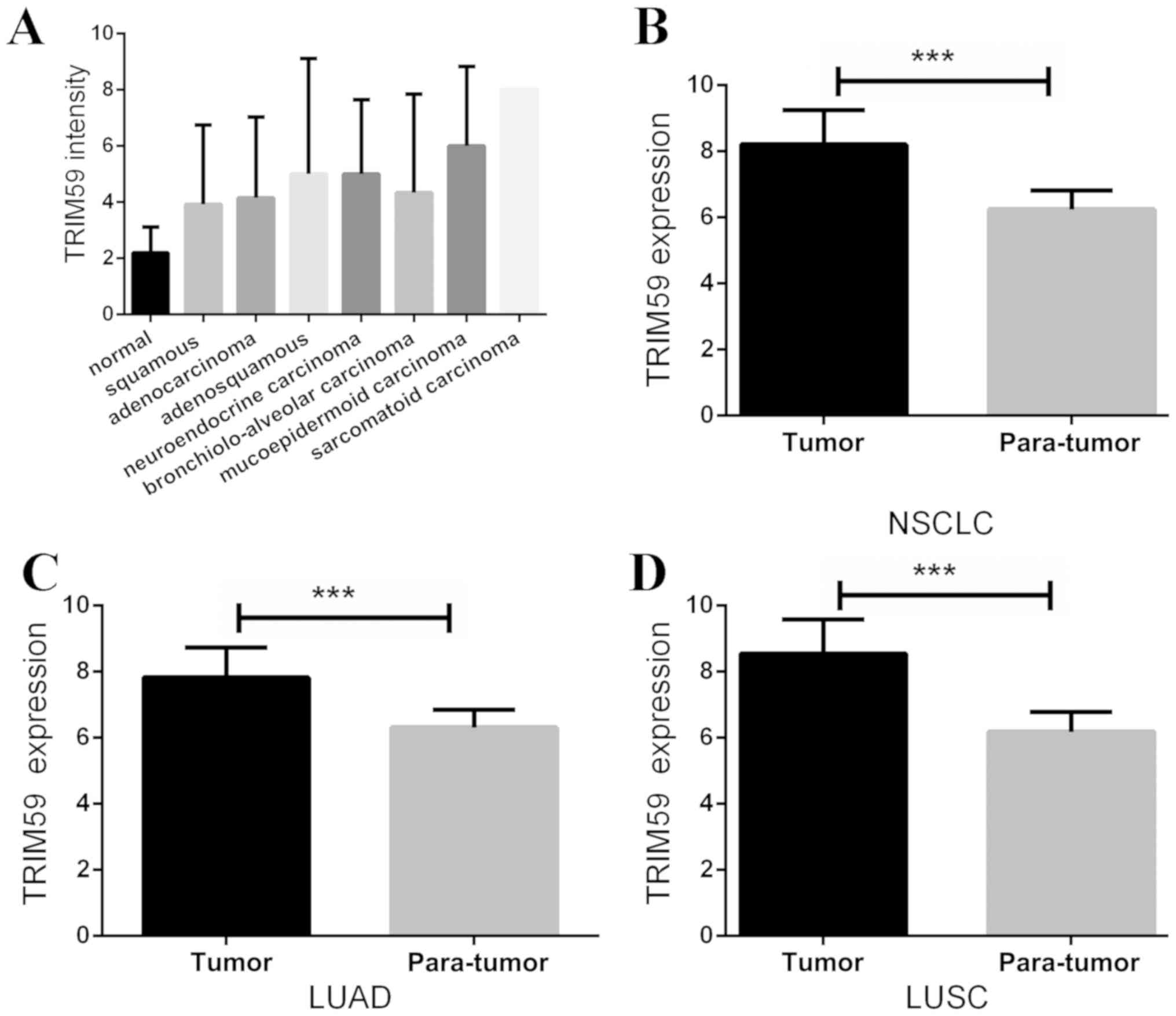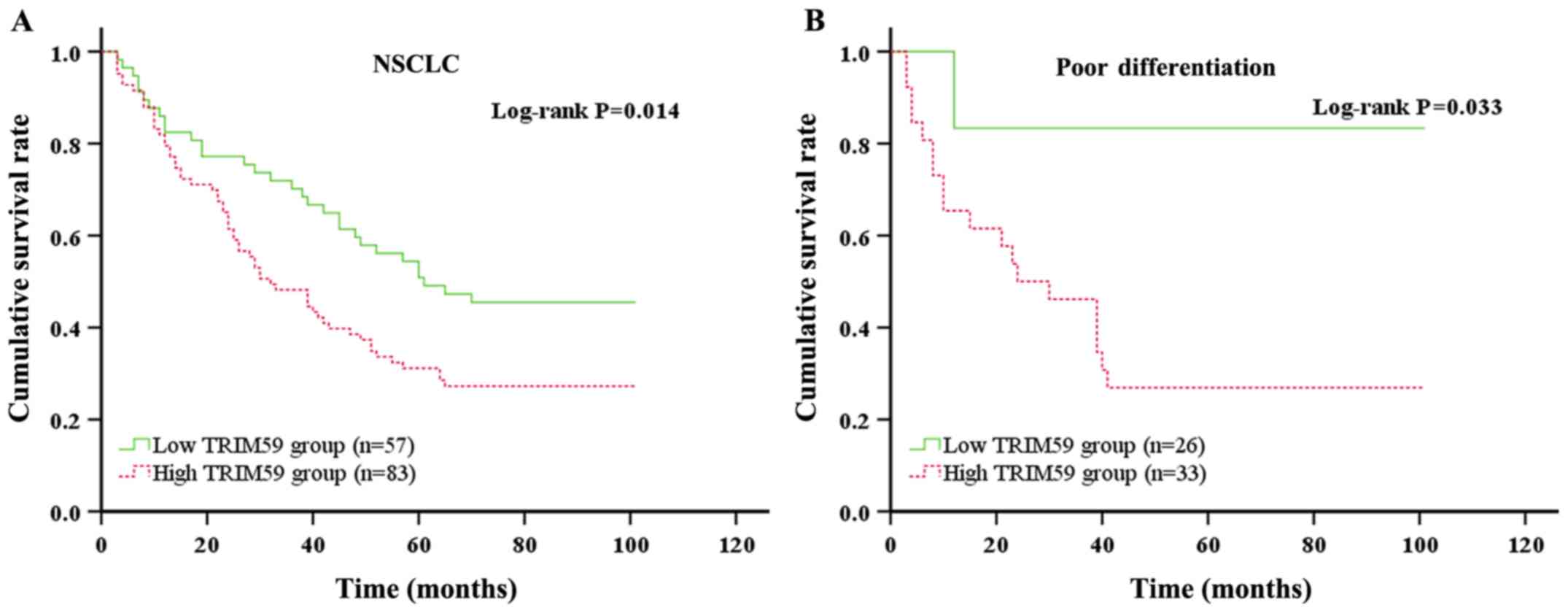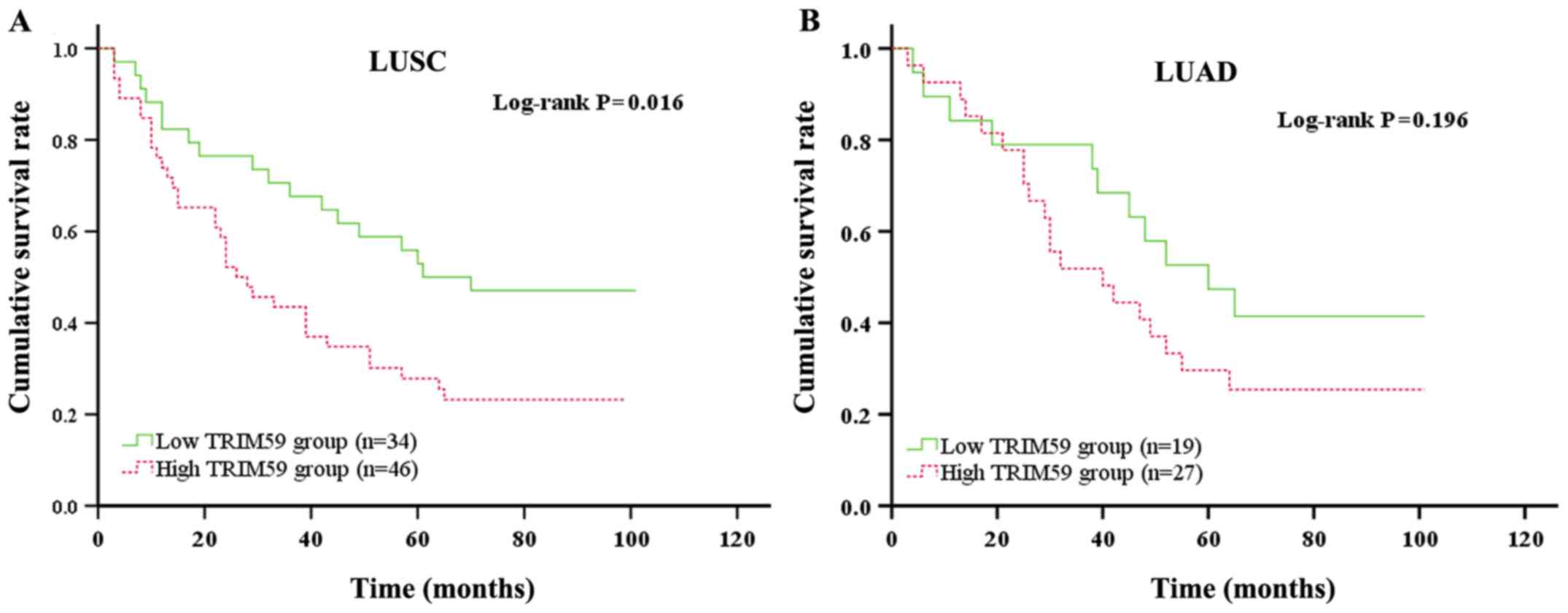|
1
|
Siegel RL, Miller KD and Jemal A: Cancer
statistics, 2017. CA Cancer J Clin. 67:7–30. 2017. View Article : Google Scholar : PubMed/NCBI
|
|
2
|
Hoffman RM and Sanchez R: Lung cancer
screening. Med Clin North Am. 101:769–785. 2017. View Article : Google Scholar : PubMed/NCBI
|
|
3
|
Chen W, Zheng R, Zeng H and Zhang S:
Epidemiology of lung cancer in China. Thorac Cancer. 6:209–215.
2015. View Article : Google Scholar : PubMed/NCBI
|
|
4
|
Sun KX, Zheng RS, Zeng HM, Zhang SW, Zou
XN, Gu XY, Xia CF, Yang ZX, Li H, Chen WQ and He J: The incidence
and mortality of lung cancer in China, 2014. Zhonghua Zhong Liu Za
Zhi. 40:805–811. 2018.(In Chinese). PubMed/NCBI
|
|
5
|
Mengoli MC, Longo FR, Fraggetta F, Cavazza
A, Dubini A, Alì G, Guddo F, Gilioli E, Bogina G, Nannini N, et al:
The 2015 world health organization classification of lung tumors:
New entities since the 2004 classification. Pathologica. 110:39–67.
2018.PubMed/NCBI
|
|
6
|
Hirsch FR, Suda K, Wiens J and Bunn PA Jr:
New and emerging targeted treatments in advanced non-small-cell
lung cancer. Lancet. 388:1012–1024. 2016. View Article : Google Scholar : PubMed/NCBI
|
|
7
|
Li CY, Xiong DD, Huang CQ, He RQ, Liang
HW, Pan DH, Wang HL, Wang YW, Zhu HW and Chen G: Clinical value of
miR-101-3p and biological analysis of its prospective targets in
breast cancer: A study based on the cancer genome atlas (TCGA) and
bioinformatics. Med Sci Monit. 23:1857–1871. 2017. View Article : Google Scholar : PubMed/NCBI
|
|
8
|
Ikeda K and Inoue S: TRIM proteins as RING
finger E3 ubiquitin ligases. Adv Exp Med Biol. 770:27–37. 2012.
View Article : Google Scholar : PubMed/NCBI
|
|
9
|
Hatakeyama S: TRIM family proteins: Roles
in autophagy, immunity, and carcinogenesis. Trends Biochem Sci.
42:297–311. 2017. View Article : Google Scholar : PubMed/NCBI
|
|
10
|
Rajsbaum R, Garcia-Sastre A and Versteeg
GA: TRIMmunity: The roles of the TRIM E3-ubiquitin ligase family in
innate antiviral immunity. J Mol Biol. 426:1265–1284. 2014.
View Article : Google Scholar : PubMed/NCBI
|
|
11
|
Chen W, Zhao K, Miao C, Xu A, Zhang J, Zhu
J, Su S and Wang Z: Silencing Trim59 inhibits invasion/migration
and epithelial-to-mesenchymal transition via TGF-β/Smad2/3
signaling pathway in bladder cancer cells. Onco Targets Ther.
10:1503–1512. 2017. View Article : Google Scholar : PubMed/NCBI
|
|
12
|
Liu Y, Dong Y, Zhao L, Su L, Diao K and Mi
X: TRIM59 overexpression correlates with poor prognosis and
contributes to breast cancer progression through AKT signaling
pathway. Mol Carcinog. 57:1792–1802. 2018. View Article : Google Scholar : PubMed/NCBI
|
|
13
|
Lin WY, Wang H, Song X, Zhang SX, Zhou PS,
Sun JM and Li JS: Knockdown of tripartite motif 59 (TRIM59)
inhibits tumor growth in prostate cancer. Eur Rev Med Pharmacol
Sci. 20:4864–4873. 2016.PubMed/NCBI
|
|
14
|
Zhang Y and Yang WB: Down-regulation of
tripartite motif protein 59 inhibits proliferation, migration and
invasion in breast cancer cells. Biomed Pharmacother. 89:462–467.
2017. View Article : Google Scholar : PubMed/NCBI
|
|
15
|
Gao R, Lv G, Zhang C, Wang X and Chen L:
TRIM59 induces epithelial-to-mesenchymal transition and promotes
migration and invasion by PI3K/AKT signaling pathway in
medulloblastoma. Oncol Lett. 15:8253–8260. 2018.PubMed/NCBI
|
|
16
|
Yuan Y, Van Allen EM, Omberg L, Wagle N,
Amin-Mansour A, Sokolov A, Byers LA, Xu Y, Hess KR, Diao L, et al:
Assessing the clinical utility of cancer genomic and proteomic data
across tumor types. Nat Biotechnol. 32:644–652. 2014. View Article : Google Scholar : PubMed/NCBI
|
|
17
|
Jin Y, Chen M and Yu X: Comparison of the
7(th) and proposed 8(th) editions of the AJCC/UICC TNM staging
system for non-small cell lung cancer undergoing radical surgery.
Sci Rep. 6:335872016. View Article : Google Scholar : PubMed/NCBI
|
|
18
|
Gao ZJ, Wang Y, Yuan WD, Yuan JQ and Yuan
K: HIF-2α not HIF-1α overexpression confers poor prognosis in
non-small cell lung cancer. Tumour Biol. 39:10104283177096372017.
View Article : Google Scholar : PubMed/NCBI
|
|
19
|
Li XR, Ji F, Ouyang J, Wu W, Qian LY and
Yang KY: Overexpression of RhoA is associated with poor prognosis
in hepatocellular carcinoma. Eur J Surg Oncol. 32:1130–1134. 2006.
View Article : Google Scholar : PubMed/NCBI
|
|
20
|
Xu H, Yu S, Yuan X, Xiong J, Kuang D,
Pestell RG and Wu K: DACH1 suppresses breast cancer as a negative
regulator of CD44. Sci Rep. 7:43612017. View Article : Google Scholar : PubMed/NCBI
|
|
21
|
Esposito D, Koliopoulos MG and Rittinger
K: Structural determinants of TRIM protein function. Biochem Soc
Trans. 45:183–191. 2017. View Article : Google Scholar : PubMed/NCBI
|
|
22
|
Micale L, Chaignat E, Fusco C, Reymond A
and Merla G: The tripartite motif: Structure and function. Adv Exp
Med Biol. 770:11–25. 2012. View Article : Google Scholar : PubMed/NCBI
|
|
23
|
Streich FC Jr, Ronchi VP, Connick JP and
Haas AL: Tripartite motif ligases catalyze polyubiquitin chain
formation through a cooperative allosteric mechanism. J Biol Chem.
288:8209–8221. 2013. View Article : Google Scholar : PubMed/NCBI
|
|
24
|
Ozato K, Shin DM, Chang TH and Morse HC
III: TRIM family proteins and their emerging roles in innate
immunity. Nat Rev Immunol. 8:849–860. 2008. View Article : Google Scholar : PubMed/NCBI
|
|
25
|
McNab FW, Rajsbaum R, Stoye JP and O'Garra
A: Tripartite- motif proteins and innate immune regulation. Curr
Opin Immunol. 23:46–56. 2011. View Article : Google Scholar : PubMed/NCBI
|
|
26
|
Chan E, Towers GJ and Qasim W: Gene
therapy strategies to exploit TRIM derived restriction factors
against HIV-1. Viruses. 6:243–263. 2014. View Article : Google Scholar : PubMed/NCBI
|
|
27
|
Tomar D and Singh R: TRIM family proteins:
Emerging class of RING E3 ligases as regulator of NF-κB pathway.
Biol Cell. 107:22–40. 2015. View Article : Google Scholar : PubMed/NCBI
|
|
28
|
Gushchina LV, Kwiatkowski TA, Bhattacharya
S and Weisleder NL: Conserved structural and functional aspects of
the tripartite motif gene family point towards therapeutic
applications in multiple diseases. Pharmacol Ther. 185:12–25. 2018.
View Article : Google Scholar : PubMed/NCBI
|
|
29
|
Han T, Guo M, Gan M, Yu B, Tian X and Wang
JB: TRIM59 regulates autophagy through modulating both the
transcription and the ubiquitination of BECN1. Autophagy.
14:2035–2048. 2018. View Article : Google Scholar : PubMed/NCBI
|
|
30
|
Zhou Z, Ji Z, Wang Y, Li J, Cao H, Zhu HH
and Gao WQ: TRIM59 is up-regulated in gastric tumors, promoting
ubiquitination and degradation of p53. Gastroenterology.
147:1043–1054. 2014. View Article : Google Scholar : PubMed/NCBI
|
|
31
|
Watanabe M and Hatakeyama S: TRIM proteins
and diseases. J Biochem. 161:135–144. 2017.PubMed/NCBI
|
|
32
|
Song X, Fu C, Yang X, Sun D, Zhang X and
Zhang J: Tripartite motif-containing 29 as a novel biomarker in
non-small cell lung cancer. Oncol Lett. 10:2283–2288. 2015.
View Article : Google Scholar : PubMed/NCBI
|
|
33
|
Dai HY, Ma Y, Da Z and Hou XM: Knockdown
of TRIM66 inhibits malignant behavior and epithelial-mesenchymal
transition in non-small cell lung cancer. Pathol Res Pract.
214:1130–1135. 2018. View Article : Google Scholar : PubMed/NCBI
|
|
34
|
Luo Q, Lin H, Ye X, Huang J, Lu S and Xu
L: Trim44 facilitates the migration and invasion of human lung
cancer cells via the NF-κB signaling pathway. Int J Clin Oncol.
20:508–517. 2015. View Article : Google Scholar : PubMed/NCBI
|
|
35
|
Chen G, Chen W, Ye M, Tan W and Jia B:
TRIM59 knockdown inhibits cell proliferation by down-regulating the
Wnt/β-catenin signaling pathway in neuroblastoma. Biosci Rep.
39(pii): BSR201812772019. View Article : Google Scholar : PubMed/NCBI
|
|
36
|
Liang J, Xing D, Li Z, Shen J, Zhao H and
Li S: TRIM59 is upregulated and promotes cell proliferation and
migration in human osteosarcoma. Mol Med Rep. 13:5200–5206. 2016.
View Article : Google Scholar : PubMed/NCBI
|
|
37
|
Sun Y, Ji B, Feng Y, Zhang Y, Ji D, Zhu C,
Wang S, Zhang C, Zhang D and Sun Y: TRIM59 facilitates the
proliferation of colorectal cancer and promotes metastasis via the
PI3K/AKT pathway. Oncol Rep. 38:43–52. 2017. View Article : Google Scholar : PubMed/NCBI
|
|
38
|
Valiyeva F, Jiang F, Elmaadawi A, Moussa
M, Yee SP, Raptis L, Izawa JI, Yang BB, Greenberg NM, Wang F and
Xuan JW: Characterization of the oncogenic activity of the novel
TRIM59 gene in mouse cancer models. Mol Cancer Ther. 10:1229–1240.
2011. View Article : Google Scholar : PubMed/NCBI
|
|
39
|
Khatamianfar V, Valiyeva F, Rennie PS, Lu
WY, Yang BB, Bauman GS, Moussa M and Xuan JW: TRIM59, a novel
multiple cancer biomarker for immunohistochemical detection of
tumorigenesis. BMJ Open. 2(pii): e0014102012. View Article : Google Scholar : PubMed/NCBI
|
|
40
|
Zhan W, Han T, Zhang C, Xie C, Gan M, Deng
K, Fu M and Wang JB: TRIM59 promotes the proliferation and
migration of non-small cell lung cancer cells by upregulating cell
cycle related proteins. PLoS One. 10:e01425962015. View Article : Google Scholar : PubMed/NCBI
|















